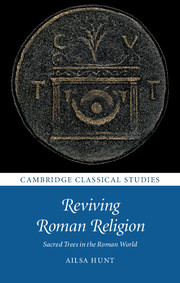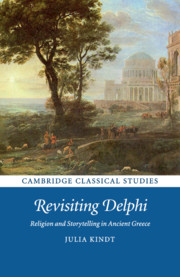Refine search
Actions for selected content:
23990 results in Ancient history
3 - Euripides: Ironic Readings of Apollo and his Prophecies
-
- Book:
- Revisiting Delphi
- Published online:
- 05 September 2016
- Print publication:
- 26 September 2016, pp 55-86
-
- Chapter
- Export citation
1 - Introduction: Revisiting Delphi
-
- Book:
- Revisiting Delphi
- Published online:
- 05 September 2016
- Print publication:
- 26 September 2016, pp 1-15
-
- Chapter
- Export citation
Frontmatter
-
- Book:
- Revisiting Delphi
- Published online:
- 05 September 2016
- Print publication:
- 26 September 2016, pp i-iv
-
- Chapter
- Export citation
5 - Confronting arboreal agency: reading the divine in arboreal behaviour
-
- Book:
- Reviving Roman Religion
- Published online:
- 05 September 2016
- Print publication:
- 12 September 2016, pp 173-223
-
- Chapter
- Export citation
7 - Branching out: what sacred trees mean for Roman religion
-
- Book:
- Reviving Roman Religion
- Published online:
- 05 September 2016
- Print publication:
- 12 September 2016, pp 292-294
-
- Chapter
- Export citation
3 - How arboreal matter matters: rethinking sacrality through trees
-
- Book:
- Reviving Roman Religion
- Published online:
- 05 September 2016
- Print publication:
- 12 September 2016, pp 72-120
-
- Chapter
- Export citation
1 - Rooting in: why give time to sacred trees?
-
- Book:
- Reviving Roman Religion
- Published online:
- 05 September 2016
- Print publication:
- 12 September 2016, pp 1-28
-
- Chapter
- Export citation
Frontmatter
-
- Book:
- Reviving Roman Religion
- Published online:
- 05 September 2016
- Print publication:
- 12 September 2016, pp i-vi
-
- Chapter
- Export citation
Contents
-
- Book:
- Reviving Roman Religion
- Published online:
- 05 September 2016
- Print publication:
- 12 September 2016, pp ix-ix
-
- Chapter
- Export citation
Index
-
- Book:
- Reviving Roman Religion
- Published online:
- 05 September 2016
- Print publication:
- 12 September 2016, pp 328-333
-
- Chapter
- Export citation
List of figures
-
- Book:
- Reviving Roman Religion
- Published online:
- 05 September 2016
- Print publication:
- 12 September 2016, pp x-x
-
- Chapter
- Export citation
2 - A brief history of tree thinking: the enduring power of animism
-
- Book:
- Reviving Roman Religion
- Published online:
- 05 September 2016
- Print publication:
- 12 September 2016, pp 29-71
-
- Chapter
- Export citation
Acknowledgements
-
- Book:
- Reviving Roman Religion
- Published online:
- 05 September 2016
- Print publication:
- 12 September 2016, pp xi-xii
-
- Chapter
- Export citation
Bibliography
-
- Book:
- Reviving Roman Religion
- Published online:
- 05 September 2016
- Print publication:
- 12 September 2016, pp 302-327
-
- Chapter
- Export citation
Appendix
-
- Book:
- Reviving Roman Religion
- Published online:
- 05 September 2016
- Print publication:
- 12 September 2016, pp 295-301
-
- Chapter
- Export citation
4 - Arboriculture and arboreal deaths: rethinking sacrality again
-
- Book:
- Reviving Roman Religion
- Published online:
- 05 September 2016
- Print publication:
- 12 September 2016, pp 121-172
-
- Chapter
- Export citation
Dedication
-
- Book:
- Reviving Roman Religion
- Published online:
- 05 September 2016
- Print publication:
- 12 September 2016, pp vii-viii
-
- Chapter
- Export citation
6 - Imagining the gods: how trees flesh out the identity of the divine
-
- Book:
- Reviving Roman Religion
- Published online:
- 05 September 2016
- Print publication:
- 12 September 2016, pp 224-291
-
- Chapter
- Export citation

Reviving Roman Religion
- Sacred Trees in the Roman World
-
- Published online:
- 05 September 2016
- Print publication:
- 12 September 2016

Revisiting Delphi
- Religion and Storytelling in Ancient Greece
-
- Published online:
- 05 September 2016
- Print publication:
- 26 September 2016
